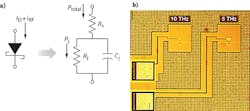Terahertz Detectors: CMOS Schottky diodes lower cost and raise far-IR responsivity of electronic detectors 14X
Researchers from the University of Texas at Dallas (UT Dallas; Richardson, TX), in cooperation with JWG Universitat Frankfurt (Frankfurt, Germany) and Vilnius University (Vilnius, Lithuania), are using Schottky barrier diodes in a 130 nm CMOS process operating above their cutoff frequency for detection of terahertz radiation at 9.74 THz. The frequency of the detected signals is the highest achieved for electronic detection and, unlike thermal detectors used at this frequency range, these CMOS electronic detectors do not require thermal isolation.
The nearly 10 THz CMOS detector has a 14 V/W optical responsivity—nearly 14 times higher than that of the previously reported maximum 9 THz third-order detection result using an n-channel metal-oxide-semiconductor field-effect transistor (MOSFET) or NMOS detector. Furthermore, at 9.74 THz, the shot-noise-limited noise-equivalent power (NEP) is approximately 2 nW/Hz0.5. Fabrication of the Schottky diodes does not require any modifications to the CMOS process. The detectors were characterized using a tunable free-electron laser (FEL) source with 30 ps pulse lengths at Helmholtz-Zentrum (Dresden-Rossendorf, Germany).
Direct-antenna matching
To fabricate the detectors, an on-chip patch antenna tuned at 10 THz is built using metal layers available in the CMOS technology. The two lowest metal layers in the process are shunted together to form a ground plane for the antenna. This ground plane also shields signals from the lossy semiconducting silicon substrate below. To reduce the travel length for the terahertz signal while maintaining close to 90% antenna efficiency, the patch was fabricated using metal layers around 2.4 μm above the ground plane.
Rather than using conventional conjugate impedance matching to maximize signal power transfer from the antenna to detector, the researchers used direct-antenna matching. At these operating frequencies, more signal power can be transferred to the detector by not having the matching work because of the increased conduction and radiation losses of the network needed for conjugate matching. A pixel occupies an area of approximately 8 × 8 μm.
The researchers say this work paves the way for electronic far-infrared (far-IR) detectors with a lower cost and a higher pixel density than that of thermal detectors. "It is fantastic that 10 THz signals can be electronically detected using CMOS circuits," says Zeshan Ahman, the lead researcher of the work and member of the Texas Analog Center of Excellence at UT Dallas. "It appears that detection of 40 THz signals for night vision is within reach."
Robert Doering, research strategy manager at Texas Instruments, says, "This technology could provide a very superior means to use the infrared portion of the spectrum. Detecting infrared radiation directly from CMOS integrated circuits will enable a wide variety of important new applications."
REFERENCE
1. See http://bit.ly/1LchVv9.
About the Author

Gail Overton
Senior Editor (2004-2020)
Gail has more than 30 years of engineering, marketing, product management, and editorial experience in the photonics and optical communications industry. Before joining the staff at Laser Focus World in 2004, she held many product management and product marketing roles in the fiber-optics industry, most notably at Hughes (El Segundo, CA), GTE Labs (Waltham, MA), Corning (Corning, NY), Photon Kinetics (Beaverton, OR), and Newport Corporation (Irvine, CA). During her marketing career, Gail published articles in WDM Solutions and Sensors magazine and traveled internationally to conduct product and sales training. Gail received her BS degree in physics, with an emphasis in optics, from San Diego State University in San Diego, CA in May 1986.
